Automatic transmission fluid MITSUBISHI L200 2015 Owner's Manual (in English)
[x] Cancel search | Manufacturer: MITSUBISHI, Model Year: 2015, Model line: L200, Model: MITSUBISHI L200 2015Pages: 418, PDF Size: 25.8 MB
Page 94 of 418
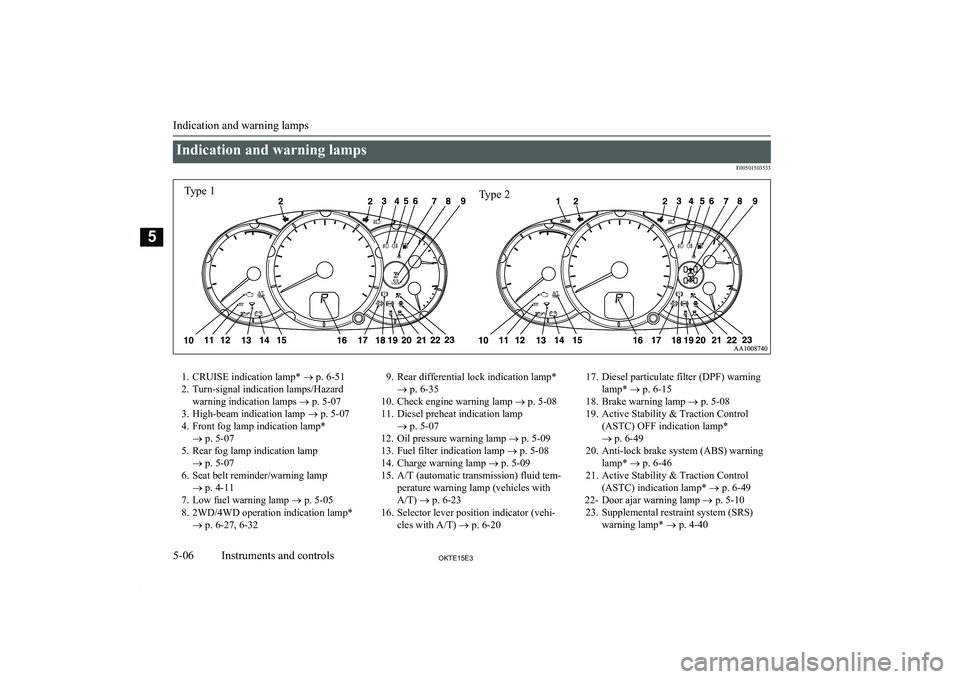
Indication and warning lampsE005015035331. CRUISE indication lamp* ® p. 6-51
2. Turn-signal indication lamps/Hazard warning indication lamps ® p. 5-07
3. High-beam indication lamp ® p. 5-07
4. Front fog lamp indication lamp* ® p. 5-07
5. Rear fog lamp indication lamp ® p. 5-07
6. Seat belt reminder/warning lamp ® p. 4-11
7. Low fuel warning lamp ® p. 5-05
8. 2WD/4WD operation indication lamp* ® p. 6-27, 6-329. Rear differential lock indication lamp*
® p. 6-35
10. Check engine warning lamp ® p. 5-08
11. Diesel preheat indication lamp ® p. 5-07
12. Oil pressure warning lamp ® p. 5-09
13. Fuel filter indication lamp ® p. 5-08
14. Charge warning lamp ® p. 5-09
15. A/T (automatic transmission) fluid tem- perature warning lamp (vehicles with
A/T) ® p. 6-23
16. Selector lever position indicator (vehi- cles with A/T) ® p. 6-2017. Diesel particulate filter (DPF) warning
lamp* ® p. 6-15
18. Brake warning lamp ® p. 5-08
19. Active Stability & Traction Control (ASTC) OFF indication lamp*
® p. 6-49
20. Anti-lock brake system (ABS) warning lamp* ® p. 6-46
21. Active Stability & Traction Control (ASTC) indication lamp* ® p. 6-49
22- Door ajar warning lamp ® p. 5-10
23. Supplemental restraint system (SRS) warning lamp* ® p. 4-40
Indication and warning lamps
5-06OKTE15E3Instruments and controls5Type 1Type 2
Page 96 of 418
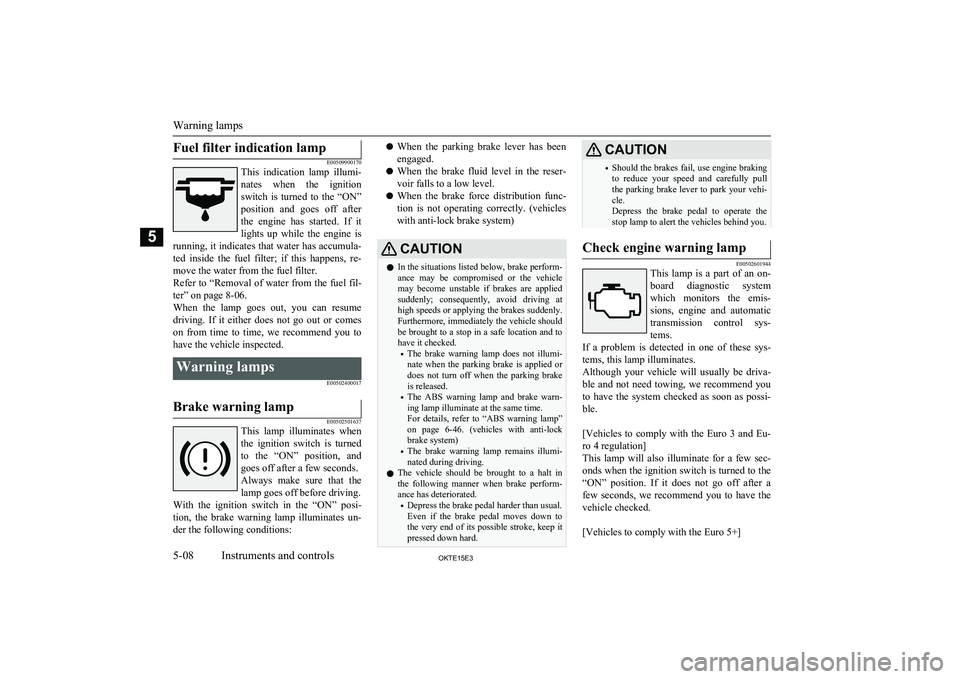
Fuel filter indication lamp
E00509900170
This indication lamp illumi-
nates when the ignition switch is turned to the “ON”
position and goes off after the engine has started. If itlights up while the engine is
running, it indicates that water has accumula- ted inside the fuel filter; if this happens, re-
move the water from the fuel filter.
Refer to “Removal of water from the fuel fil- ter” on page 8-06.When the lamp goes out, you can resume
driving. If it either does not go out or comes on from time to time, we recommend you to
have the vehicle inspected.Warning lamps
E00502400017Brake warning lamp
E00502501637
This lamp illuminates whenthe ignition switch is turnedto the “ON” position, and goes off after a few seconds.
Always make sure that the
lamp goes off before driving.
With the ignition switch in the “ON” posi-
tion, the brake warning lamp illuminates un- der the following conditions:
l When the parking brake lever has been
engaged.
l When the brake fluid level in the reser-
voir falls to a low level.
l When the brake force distribution func-
tion is not operating correctly. (vehicles
with anti-lock brake system)CAUTIONl In the situations listed below, brake perform-
ance may be compromised or the vehicle
may become unstable if brakes are applied
suddenly; consequently, avoid driving at high speeds or applying the brakes suddenly.
Furthermore, immediately the vehicle should be brought to a stop in a safe location and to have it checked.
• The brake warning lamp does not illumi-
nate when the parking brake is applied ordoes not turn off when the parking brake is released.
• The ABS warning lamp and brake warn-
ing lamp illuminate at the same time.
For details, refer to “ABS warning lamp”
on page 6-46. (vehicles with anti-lock
brake system)
• The brake warning lamp remains illumi-
nated during driving.
l The vehicle should be brought to a halt in
the following manner when brake perform-
ance has deteriorated.
• Depress the brake pedal harder than usual.
Even if the brake pedal moves down to
the very end of its possible stroke, keep it
pressed down hard.CAUTION• Should the brakes fail, use engine braking
to reduce your speed and carefully pull the parking brake lever to park your vehi-
cle.
Depress the brake pedal to operate the
stop lamp to alert the vehicles behind you.Check engine warning lamp
E00502601944
This lamp is a part of an on-
board diagnostic system
which monitors the emis-
sions, engine and automatic transmission control sys-tems.
If a problem is detected in one of these sys- tems, this lamp illuminates.
Although your vehicle will usually be driva-
ble and not need towing, we recommend you
to have the system checked as soon as possi-
ble.
[Vehicles to comply with the Euro 3 and Eu-
ro 4 regulation]
This lamp will also illuminate for a few sec- onds when the ignition switch is turned to the “ON” position. If it does not go off after a
few seconds, we recommend you to have the vehicle checked.
[Vehicles to comply with the Euro 5+]
Warning lamps
5-08OKTE15E3Instruments and controls5
Page 155 of 418
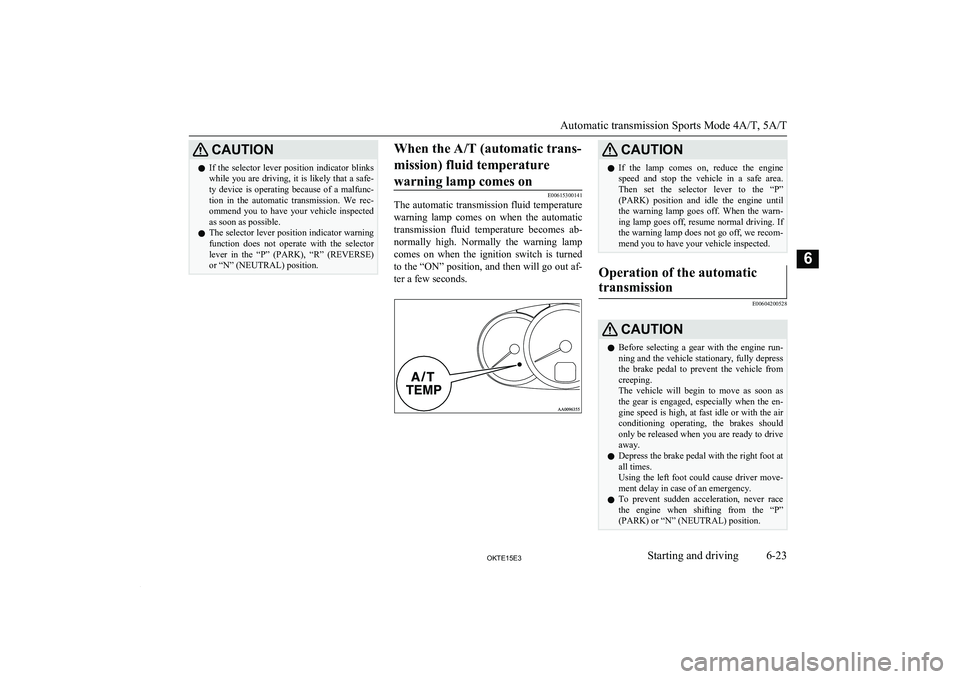
CAUTIONlIf the selector lever position indicator blinks
while you are driving, it is likely that a safe-
ty device is operating because of a malfunc-
tion in the automatic transmission. We rec-
ommend you to have your vehicle inspected as soon as possible.
l The selector lever position indicator warning
function does not operate with the selector
lever in the “P” (PARK), “R” (REVERSE) or “N” (NEUTRAL) position.When the A/T (automatic trans-
mission) fluid temperature warning lamp comes on
E00615300141
The automatic transmission fluid temperature
warning lamp comes on when the automatic
transmission fluid temperature becomes ab- normally high. Normally the warning lamp
comes on when the ignition switch is turned to the “ON” position, and then will go out af-
ter a few seconds.
CAUTIONl If the lamp comes on, reduce the engine
speed and stop the vehicle in a safe area.Then set the selector lever to the “P”
(PARK) position and idle the engine until
the warning lamp goes off. When the warn- ing lamp goes off, resume normal driving. If
the warning lamp does not go off, we recom- mend you to have your vehicle inspected.Operation of the automatic
transmission
E00604200528
CAUTIONl Before selecting a gear with the engine run-
ning and the vehicle stationary, fully depress
the brake pedal to prevent the vehicle from
creeping.
The vehicle will begin to move as soon as the gear is engaged, especially when the en- gine speed is high, at fast idle or with the airconditioning operating, the brakes should
only be released when you are ready to drive
away.
l Depress the brake pedal with the right foot at
all times.
Using the left foot could cause driver move- ment delay in case of an emergency.
l To prevent sudden acceleration, never race
the engine when shifting from the “P”
(PARK) or “N” (NEUTRAL) position.
Automatic transmission Sports Mode 4A/T, 5A/T
6-23OKTE15E3Starting and driving6
Page 171 of 418
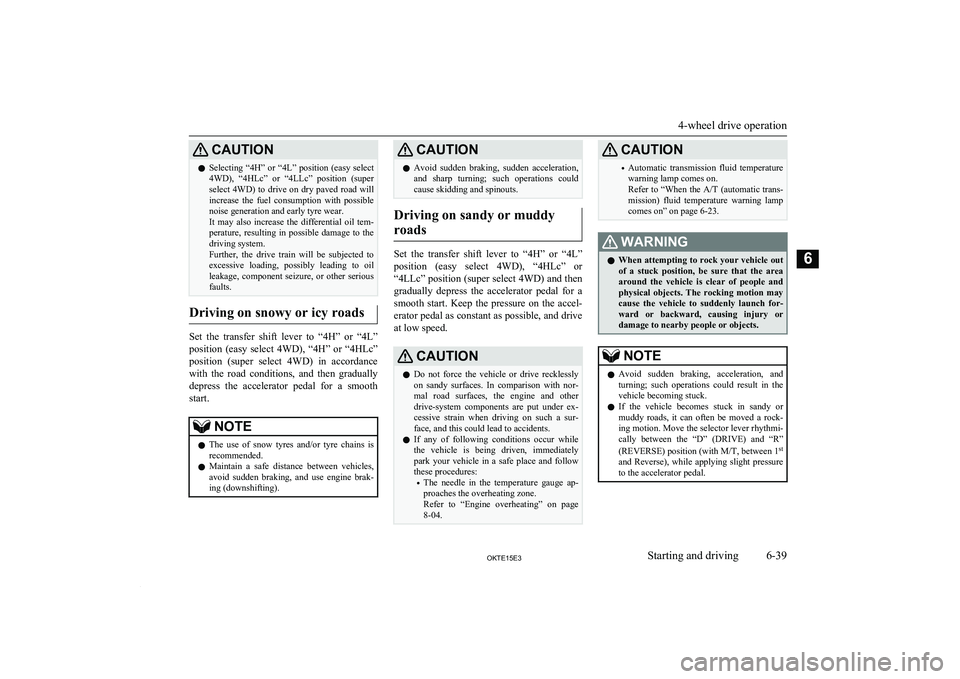
CAUTIONlSelecting “4H” or “4L” position (easy select
4WD), “4HLc” or “4LLc” position (super
select 4WD) to drive on dry paved road will
increase the fuel consumption with possible noise generation and early tyre wear.
It may also increase the differential oil tem- perature, resulting in possible damage to the
driving system.
Further, the drive train will be subjected to excessive loading, possibly leading to oilleakage, component seizure, or other serious faults.
Driving on snowy or icy roads
Set the transfer shift lever to “4H” or “4L”
position (easy select 4WD), “4H” or “4HLc” position (super select 4WD) in accordance
with the road conditions, and then gradually
depress the accelerator pedal for a smooth start.
NOTEl The use of snow tyres and/or tyre chains is
recommended.
l Maintain a safe distance between vehicles,
avoid sudden braking, and use engine brak-
ing (downshifting).CAUTIONl Avoid sudden braking, sudden acceleration,
and sharp turning; such operations could
cause skidding and spinouts.
Driving on sandy or muddy
roads
Set the transfer shift lever to “4H” or “4L”
position (easy select 4WD), “4HLc” or “4LLc” position (super select 4WD) and then
gradually depress the accelerator pedal for a
smooth start. Keep the pressure on the accel-
erator pedal as constant as possible, and drive at low speed.
CAUTIONl Do not force the vehicle or drive recklessly
on sandy surfaces. In comparison with nor-
mal road surfaces, the engine and other
drive-system components are put under ex- cessive strain when driving on such a sur-
face, and this could lead to accidents.
l If any of following conditions occur while
the vehicle is being driven, immediately park your vehicle in a safe place and follow these procedures:
• The needle in the temperature gauge ap-
proaches the overheating zone.
Refer to “Engine overheating” on page
8-04.CAUTION• Automatic transmission fluid temperature
warning lamp comes on.
Refer to “When the A/T (automatic trans-
mission) fluid temperature warning lamp comes on” on page 6-23.WARNINGl When attempting to rock your vehicle out
of a stuck position, be sure that the area
around the vehicle is clear of people and physical objects. The rocking motion may
cause the vehicle to suddenly launch for- ward or backward, causing injury or damage to nearby people or objects.NOTEl Avoid sudden braking, acceleration, and
turning; such operations could result in thevehicle becoming stuck.
l If the vehicle becomes stuck in sandy or
muddy roads, it can often be moved a rock-
ing motion. Move the selector lever rhythmi- cally between the “D” (DRIVE) and “R”
(REVERSE) position (with M/T, between 1 st
and Reverse), while applying slight pressure
to the accelerator pedal.
4-wheel drive operation
6-39OKTE15E3Starting and driving6
Page 331 of 418
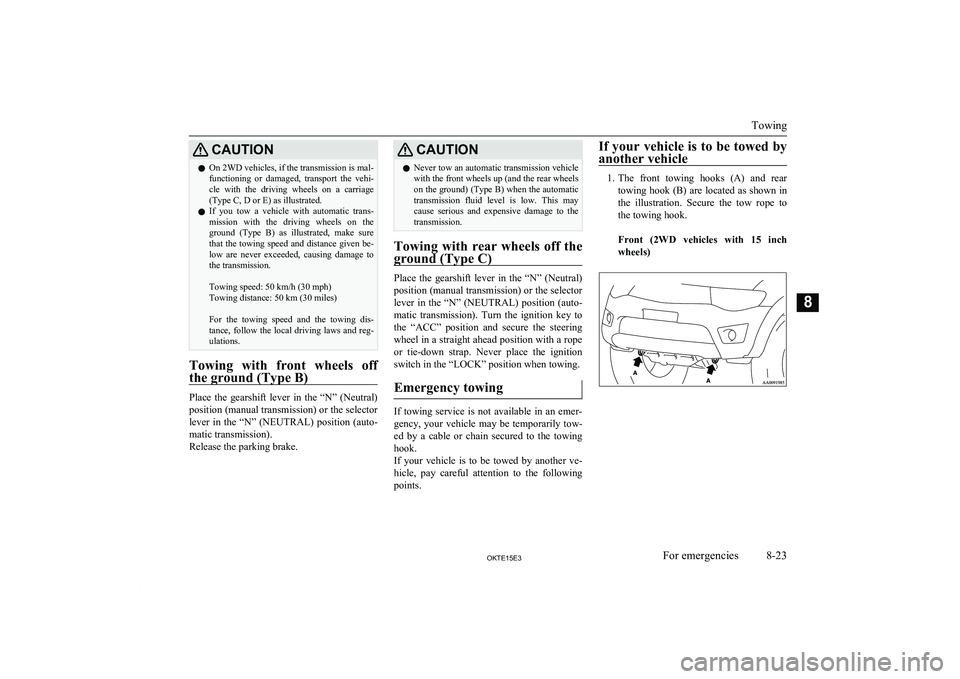
CAUTIONlOn 2WD vehicles, if the transmission is mal-
functioning or damaged, transport the vehi- cle with the driving wheels on a carriage (Type C, D or E) as illustrated.
l If you tow a vehicle with automatic trans-
mission with the driving wheels on the
ground (Type B) as illustrated, make sure
that the towing speed and distance given be- low are never exceeded, causing damage to the transmission.
Towing speed: 50 km/h (30 mph)
Towing distance: 50 km (30 miles)
For the towing speed and the towing dis- tance, follow the local driving laws and reg-
ulations.
Towing with front wheels off
the ground (Type B)
Place the gearshift lever in the “N” (Neutral) position (manual transmission) or the selector
lever in the “N” (NEUTRAL) position (auto- matic transmission).
Release the parking brake.
CAUTIONl Never tow an automatic transmission vehicle
with the front wheels up (and the rear wheels
on the ground) (Type B) when the automatic transmission fluid level is low. This may
cause serious and expensive damage to the
transmission.
Towing with rear wheels off the
ground (Type C)
Place the gearshift lever in the “N” (Neutral)
position (manual transmission) or the selector
lever in the “N” (NEUTRAL) position (auto- matic transmission). Turn the ignition key to
the “ACC” position and secure the steering wheel in a straight ahead position with a rope
or tie-down strap. Never place the ignition switch in the “LOCK” position when towing.
Emergency towing
If towing service is not available in an emer- gency, your vehicle may be temporarily tow-ed by a cable or chain secured to the towinghook.
If your vehicle is to be towed by another ve-
hicle, pay careful attention to the following
points.
If your vehicle is to be towed by
another vehicle
1. The front towing hooks (A) and rear
towing hook (B) are located as shown inthe illustration. Secure the tow rope to
the towing hook.
Front (2WD vehicles with 15 inch wheels)Towing
8-23OKTE15E3For emergencies8
Page 343 of 418
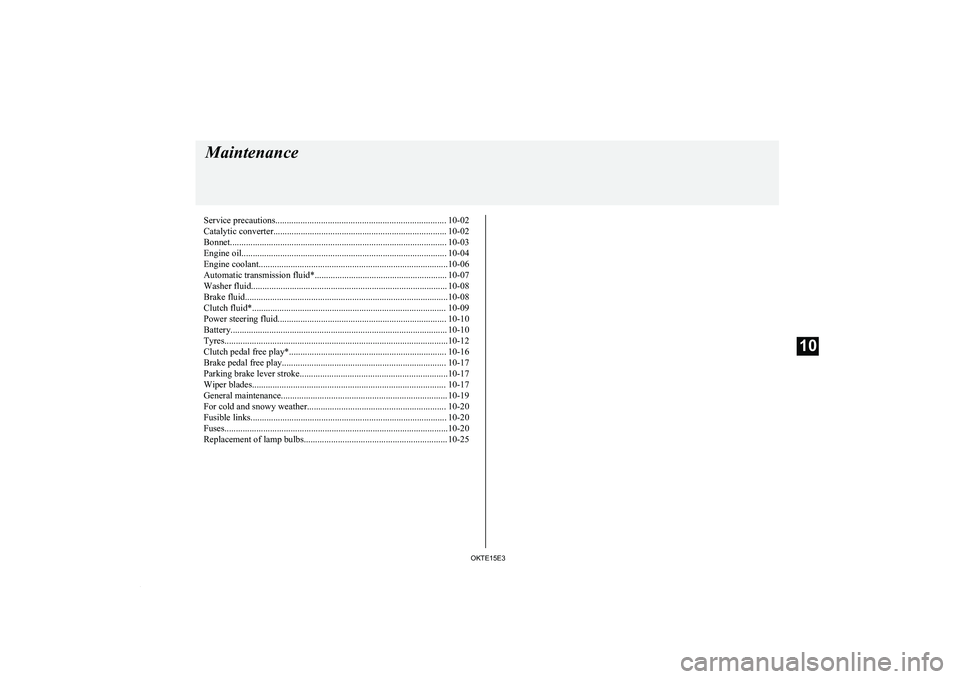
Service precautions........................................................................... 10-02
Catalytic converter............................................................................ 10-02
Bonnet............................................................................................... 10-03
Engine oil.......................................................................................... 10-04 Engine coolant...................................................................................10-06
Automatic transmission fluid*.......................................................... 10-07 Washer fluid...................................................................................... 10-08
Brake fluid.........................................................................................10-08
Clutch fluid*..................................................................................... 10-09 Power steering fluid.......................................................................... 10-10
Battery............................................................................................... 10-10 Tyres..................................................................................................10-12Clutch pedal free play*..................................................................... 10-16Brake pedal free play........................................................................ 10-17Parking brake lever stroke.................................................................10-17
Wiper blades..................................................................................... 10-17
General maintenance......................................................................... 10-19
For cold and snowy weather............................................................. 10-20
Fusible links...................................................................................... 10-20 Fuses..................................................................................................10-20
Replacement of lamp bulbs............................................................... 10-25Maintenance
OKTE15E310
Page 349 of 418
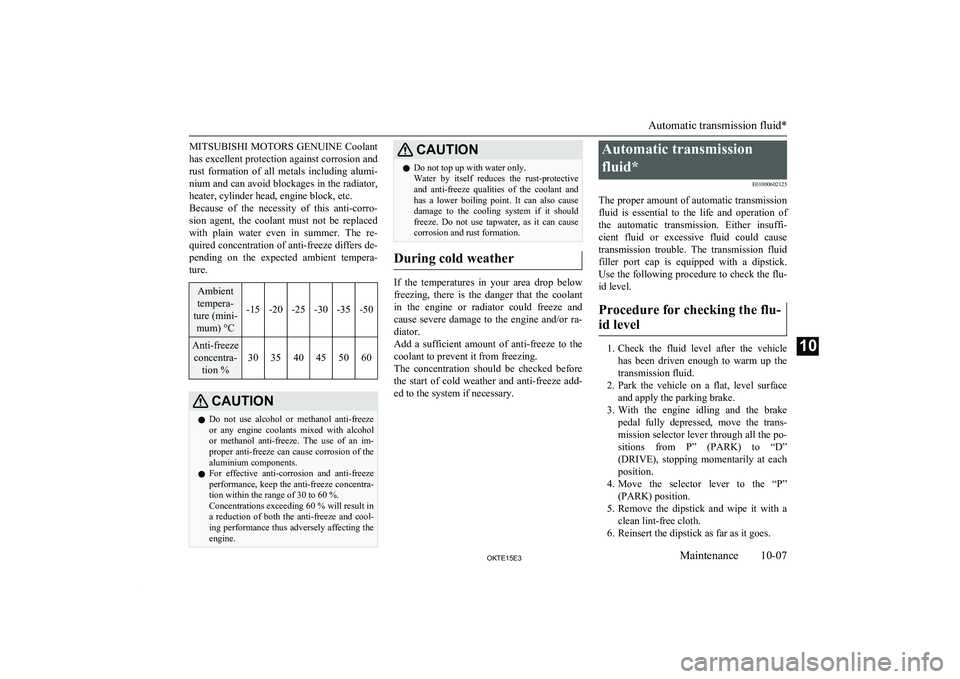
MITSUBISHI MOTORS GENUINE Coolant
has excellent protection against corrosion and rust formation of all metals including alumi-
nium and can avoid blockages in the radiator, heater, cylinder head, engine block, etc.
Because of the necessity of this anti-corro-
sion agent, the coolant must not be replaced with plain water even in summer. The re-
quired concentration of anti-freeze differs de-
pending on the expected ambient tempera- ture.Ambient
tempera-
ture (mini- mum) °C
-15-20-25-30-35-50
Anti-freezeconcentra- tion %
303540455060CAUTIONl Do not use alcohol or methanol anti-freeze
or any engine coolants mixed with alcohol
or methanol anti-freeze. The use of an im- proper anti-freeze can cause corrosion of the
aluminium components.
l For effective anti-corrosion and anti-freeze
performance, keep the anti-freeze concentra-tion within the range of 30 to 60 %.
Concentrations exceeding 60 % will result in
a reduction of both the anti-freeze and cool-
ing performance thus adversely affecting the
engine.CAUTIONl Do not top up with water only.
Water by itself reduces the rust-protective and anti-freeze qualities of the coolant and
has a lower boiling point. It can also cause damage to the cooling system if it should freeze. Do not use tapwater, as it can causecorrosion and rust formation.
During cold weather
If the temperatures in your area drop below
freezing, there is the danger that the coolant
in the engine or radiator could freeze and cause severe damage to the engine and/or ra-diator.
Add a sufficient amount of anti-freeze to the
coolant to prevent it from freezing.
The concentration should be checked before the start of cold weather and anti-freeze add- ed to the system if necessary.
Automatic transmission
fluid* E01000602125
The proper amount of automatic transmission fluid is essential to the life and operation of
the automatic transmission. Either insuffi- cient fluid or excessive fluid could causetransmission trouble. The transmission fluid filler port cap is equipped with a dipstick.Use the following procedure to check the flu-
id level.
Procedure for checking the flu- id level
1. Check the fluid level after the vehicle
has been driven enough to warm up the
transmission fluid.
2. Park the vehicle on a flat, level surface
and apply the parking brake.
3. With the engine idling and the brake
pedal fully depressed, move the trans- mission selector lever through all the po-sitions from P” (PARK) to “D”
(DRIVE), stopping momentarily at each position.
4. Move the selector lever to the “P”
(PARK) position.
5. Remove the dipstick and wipe it with a
clean lint-free cloth.
6. Reinsert the dipstick as far as it goes.
Automatic transmission fluid*
10-07OKTE15E3Maintenance10
Page 350 of 418
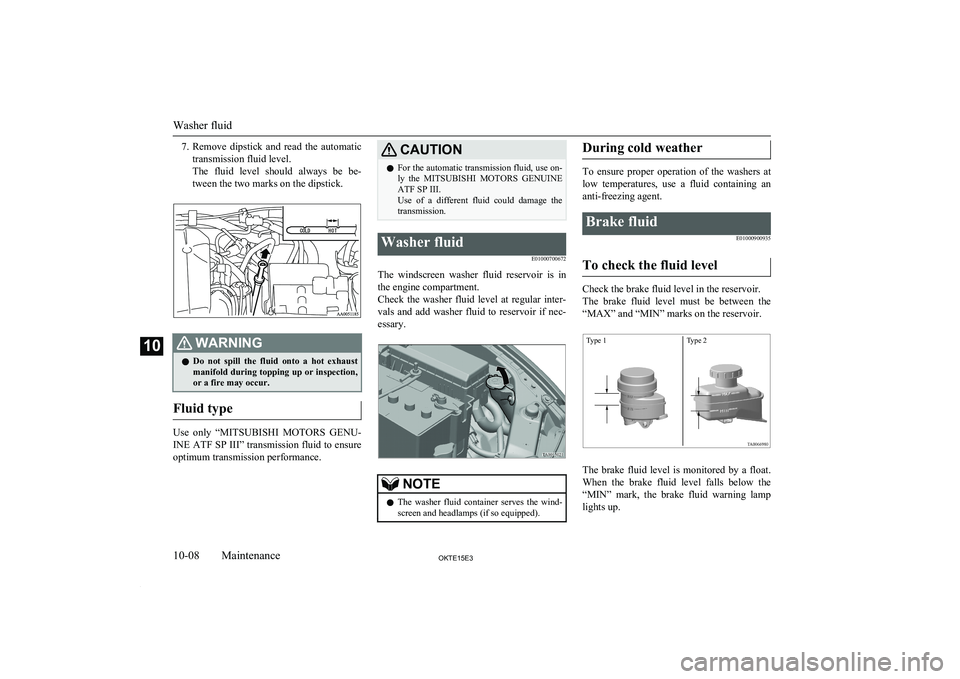
7.Remove dipstick and read the automatic
transmission fluid level.
The fluid level should always be be-
tween the two marks on the dipstick.WARNINGl Do not spill the fluid onto a hot exhaust
manifold during topping up or inspection, or a fire may occur.
Fluid type
Use only “ MITSUBISHI MOTORS GENU-
INE ATF SP III” transmission fluid to ensure
optimum transmission performance.
CAUTIONl For the automatic transmission fluid, use on-
ly the MITSUBISHI MOTORS GENUINE
ATF SP III.
Use of a different fluid could damage the transmission.Washer fluid
E01000700672
The windscreen washer fluid reservoir is inthe engine compartment.
Check the washer fluid level at regular inter- vals and add washer fluid to reservoir if nec-
essary.
NOTEl The washer fluid container serves the wind-
screen and headlamps (if so equipped).During cold weather
To ensure proper operation of the washers at
low temperatures, use a fluid containing ananti-freezing agent.
Brake fluid
E01000900935
To check the fluid level
Check the brake fluid level in the reservoir.
The brake fluid level must be between the “MAX” and “MIN” marks on the reservoir.
The brake fluid level is monitored by a float.
When the brake fluid level falls below the “MIN” mark, the brake fluid warning lamp
lights up.
Washer fluid
10-08OKTE15E3Maintenance10 Type 1 Type 2
Page 403 of 418
![MITSUBISHI L200 2015 Owners Manual (in English) No.ItemQuantityLubricants
1Engine coolant
8.2 litres
[includes 0.65 litre in the reserve tank]MITSUBISHI MOTORS GENU- INE SUPER LONG LIFECOOLANT or equivalent2Automatic transmission fluid9.7 litresRef MITSUBISHI L200 2015 Owners Manual (in English) No.ItemQuantityLubricants
1Engine coolant
8.2 litres
[includes 0.65 litre in the reserve tank]MITSUBISHI MOTORS GENU- INE SUPER LONG LIFECOOLANT or equivalent2Automatic transmission fluid9.7 litresRef](/img/19/34877/w960_34877-402.png)
No.ItemQuantityLubricants
1Engine coolant
8.2 litres
[includes 0.65 litre in the reserve tank]MITSUBISHI MOTORS GENU- INE SUPER LONG LIFECOOLANT or equivalent2Automatic transmission fluid9.7 litresRefer to page 10-07.3Brake fluidAs requiredBrake fluid DOT3 or DOT44Clutch fluidAs requiredBrake fluid DOT3 or DOT4
5Power steering fluidAs required
MITSUBISHI MOTORS GENU- INE PSF
(Power Steering Fluid)
6Engine oil
Oil pan2WD with 15 inch tyres6.5 litres
Refer to page 10-04.
2WD with 16 inch tyres, 4WD5.5 litresOil filter0.8 litreOil cooler0.1 litre7Washer fluid4.8 litres,
4.5 litres *1—8Manual transmis-
sion oil2WD2.3 litresMITSUBISHI MOTORS GENU-
INE MTF API classification GL-3 SAE 75W-854WD3.4 litres*1: Vehicles with “front (Type 1)” (Refer to “Outside” on page 10-25)
*2 : 4WD vehicles only
*3 : Double cab with capacity up air conditioning
Refill capacities
11-23OKTE15E3Specifications11
Page 405 of 418
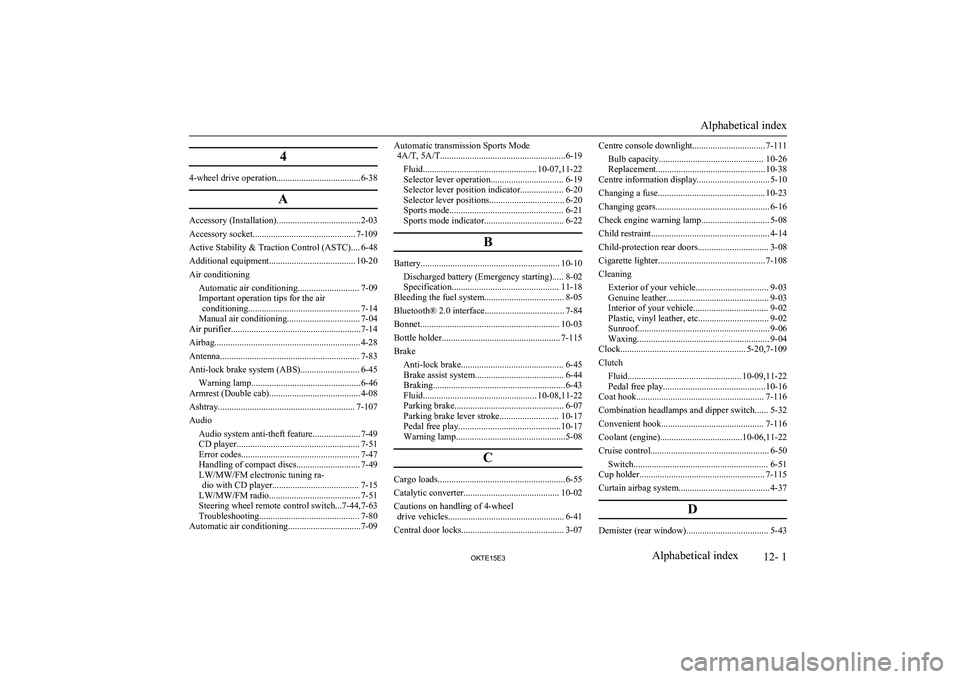
4
4-wheel drive operation.....................................6-38A
Accessory (Installation).....................................2-03
Accessory socket............................................. 7-109
Active Stability & Traction Control (ASTC).... 6-48
Additional equipment...................................... 10-20
Air conditioning Automatic air conditioning........................... 7-09
Important operation tips for the air conditioning................................................. 7-14
Manual air conditioning................................ 7-04
Air purifier.........................................................7-14
Airbag................................................................ 4-28
Antenna............................................................. 7-83
Anti-lock brake system (ABS).......................... 6-45 Warning lamp................................................6-46
Armrest (Double cab)........................................ 4-08
Ashtray............................................................ 7-107
Audio Audio system anti-theft feature..................... 7-49
CD player...................................................... 7-51
Error codes.................................................... 7-47
Handling of compact discs............................ 7-49
LW/MW/FM electronic tuning ra- dio with CD player...................................... 7-15
LW/MW/FM radio........................................ 7-51
Steering wheel remote control switch...7-44,7-63
Troubleshooting............................................ 7-80
Automatic air conditioning................................7-09
Automatic transmission Sports Mode 4A/T, 5A/T.......................................................6-19
Fluid.................................................. 10-07,11-22
Selector lever operation................................ 6-19
Selector lever position indicator................... 6-20
Selector lever positions................................. 6-20
Sports mode.................................................. 6-21
Sports mode indicator................................... 6-22
B
Battery............................................................. 10-10Discharged battery (Emergency starting)..... 8-02
Specification............................................... 11-18
Bleeding the fuel system................................... 8-05
Bluetooth® 2.0 interface................................... 7-84
Bonnet............................................................. 10-03
Bottle holder.................................................... 7-115
Brake Anti-lock brake............................................. 6-45
Brake assist system....................................... 6-44
Braking.......................................................... 6-43
Fluid.................................................. 10-08,11-22
Parking brake................................................ 6-07
Parking brake lever stroke.......................... 10-17
Pedal free play.............................................10-17
Warning lamp................................................5-08
C
Cargo loads........................................................6-55
Catalytic converter.......................................... 10-02
Cautions on handling of 4-wheel drive vehicles................................................... 6-41
Central door locks............................................. 3-07
Centre console downlight................................ 7-111 Bulb capacity.............................................. 10-26
Replacement................................................ 10-38
Centre information display................................ 5-10
Changing a fuse............................................... 10-23
Changing gears.................................................. 6-16
Check engine warning lamp.............................. 5-08
Child restraint.................................................... 4-14
Child-protection rear doors............................... 3-08
Cigarette lighter............................................... 7-108
Cleaning Exterior of your vehicle................................ 9-03Genuine leather............................................. 9-03 Interior of your vehicle................................. 9-02
Plastic, vinyl leather, etc............................... 9-02
Sunroof.......................................................... 9-06
Waxing.......................................................... 9-04
Clock....................................................... 5-20,7-109
Clutch Fluid.................................................. 10-09,11-22
Pedal free play.............................................10-16
Coat hook........................................................ 7-116
Combination headlamps and dipper switch...... 5-32
Convenient hook............................................. 7-116
Coolant (engine)....................................10-06,11-22
Cruise control.................................................... 6-50 Switch........................................................... 6-51
Cup holder....................................................... 7-115
Curtain airbag system........................................ 4-37
D
Demister (rear window).................................... 5-43
Alphabetical index
12- 1
OKTE15E3Alphabetical index